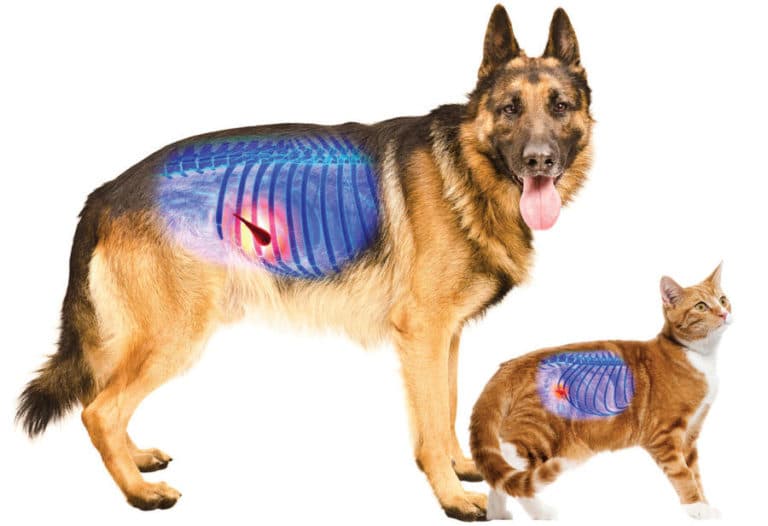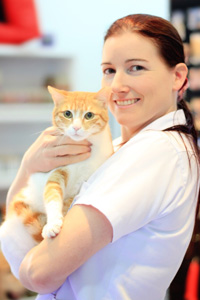A dog and cat disease that doesn’t just have a complicated name
January 06, 2021 by Dr. Sigrun Hackl

Beany has not been his usual bouncy self. The usually food loving mixed breed is refusing to eat, turning his nose away, and hiding in the corner with a sad look on his face. He vomited only once, but in the morning he was whimpering to himself. Yesterday, all was perfectly fine. He loved the family visit and snooped around for tasty treats and titbits.
Suddenly he seems so unwell and was brought in to find out what is going on.
Turns out Beany has pancreatitis, an inflammation of the pancreas. This is the organ that produces digestive juices (enzymes), and when it plays up, things can get messy.
But, how come, all of a sudden? And what about the cat, can she get it as well?
Generally, both dogs and cats are prone for pancreatitis and the complex disease appears to have many triggers. The most common ones seem to be sudden diet changes or very fatty meals, which is why we see a surge in cases after holidays and a habit of ‘sharing the Christmas feast’ with our 4 legged family members. Another fairly strong trigger appears to be stress. But the list of possible reasons is long and possibly incomplete, meaning that we actually haven’t really figured out what is going on to cause this.

Finding out about pancreatitis can be a challenge in itself, and often needs a fair bit of diagnostics. Too many other options come with the same clinical signs, and the elusive organ does not easily show its problem. Even the specific test for pancreatitis can give us misleading results, with accuracy of around 70% only. This means that in order to obtain the diagnosis, several tests are required to get a complete picture and rule out the differentials. Commonly, we will run a full blood check and an abdominal ultrasound scan, but even x-rays or repeated blood tests can be indicated.
And once we know what we are dealing with, the next challenge awaits. The pancreas, once upset, will easily react to oral medication – meaning it tends to get worse rather than better. The best approach of treatment is hospitalisation, iv fluids, injectable medication and very very very strict diet.
Diet is a key factor in this, as a full stomach will signal the pancreas that ‘we have something to digest, we need your enzymes’, and an upset pancreas will not like that kind of challenge. Instead of providing the enzymes into the gut, where they are needed, it tends to start digesting itself and its surrounding fatty tissue, a very harmful and hugely painful procedure! To avoid this, we try to keep the stomach empty, so that it won’t send the signal. This means tiny bite size meals every hour, very low fat, to never trigger a ‘hey, we need you to digest’ response and give the pancreas a chance to calm down and heal.
Full recovery is possible and prognosis is generally good, unless there are underlying factors present (ultrasound scan is used to search for those). Recovery, however, tends to be slow, and response to treatment can take many days. Patience is required, and while some can go home after 3 or 4 days, others may end up staying in hospital for a few weeks before they are ready to go home.
Once the pain levels and severe nausea are under control, and Beany takes his bite size meals, he can go home and continue nursing care with his family. But beware, pancreatitis has a high incidence of relapse. Continue the feeding instructions to the letter to avoid another flare up at home!
Common signs of pancreatitis in dogs include
Dogs will often show typical signs of an upset tummy, which is why the list of differentials is so long and needs testing to decide which one we are dealing with. Abdominal pain in dogs can be seen in the posture (tugged in tummy, arched back, reluctance to move), hard or bloated appearance of the tummy, and sometimes whimpering. Any sign of abdominal pain or distension should be checked immediately as the differentials for this symptom include some life threatening conditions.
Common signs of pancreatitis in cats include
Symptoms in cats can be even more elusive, and diagnostics are therefore even more challenging. Many cats will simply hide and refuse to eat, so the condition can have been going on for a fair bit before we actually see the cat. Acute cases tend to vomit, sometimes severely. Same as dogs, cats will experience a lot of abdominal pain with the pancreatitis, but it is not in their nature to show this easily. Their tummy may feel extremely soft when touched, they may react aggressively when picked up, or they are simply hiding away because of the pain. Drooling can sometimes be seen and is often a sign of nausea.

Veterinary Surgeon
Street 70, Next to Premier Inn Hotel, Dubai Investments Park,
Green Community – Dubai, UAE
Our Opening Hours:
Monday to Friday : 9:00 am to 9:00 pm
Saturday and Sunday : 10:00 am to 8:00 pm
Damac Hills 2 Community Mall, Dubai, UAE
Our Opening Hours:
Everyday : 9:00 am to 8:00 pm
Blue Oasis Veterinary Clinic
Copyright© 2008 All rights reserved